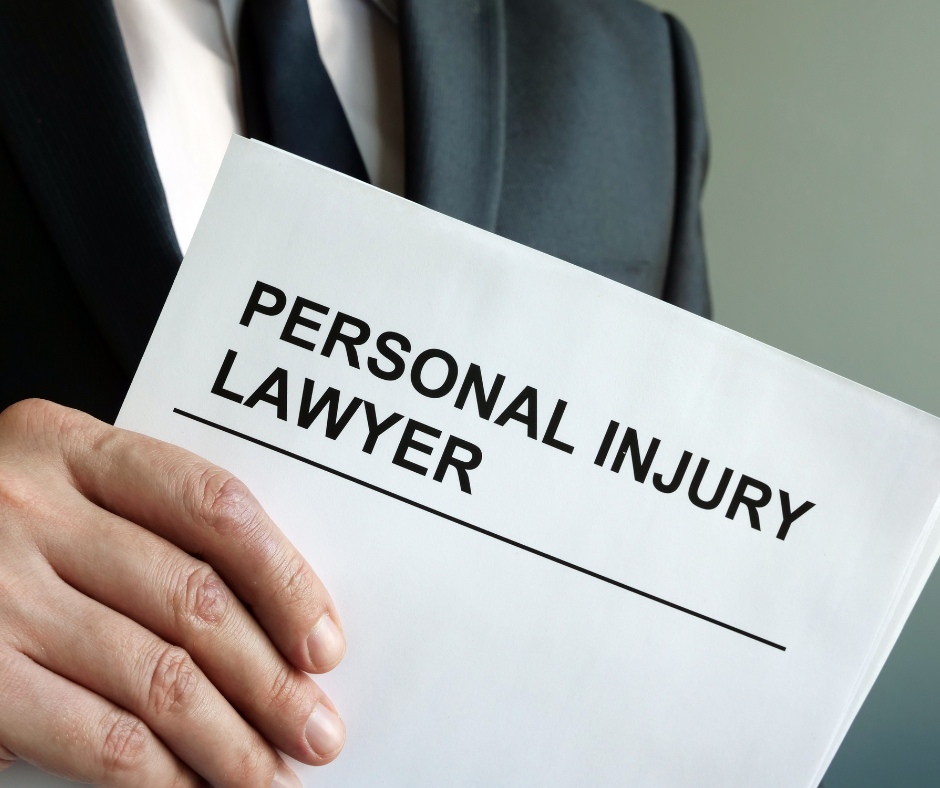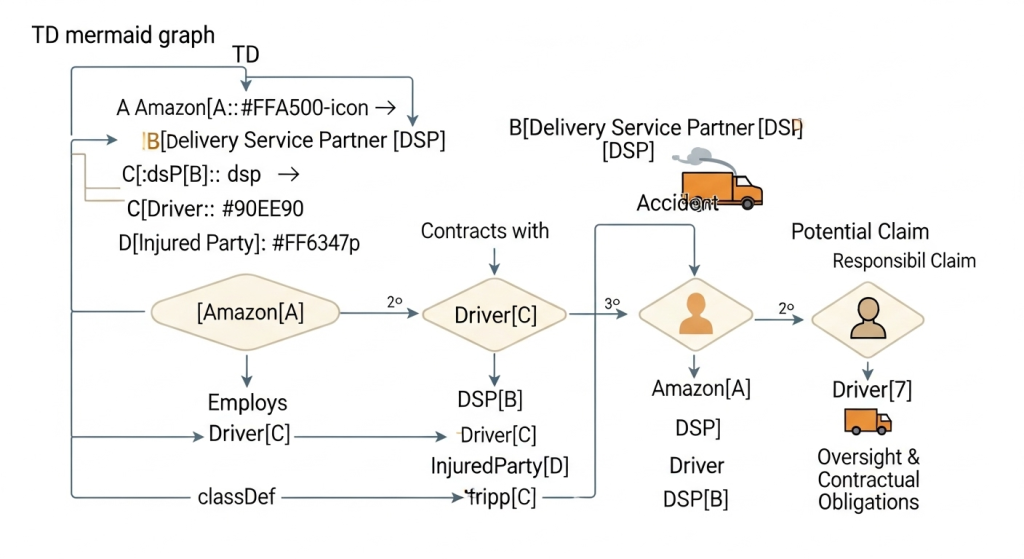Smiles Fool You.
We WIN Legal Fights!

The sight of an Amazon delivery truck or van is a daily occurrence on Texas roads. While these vehicles represent convenience, they also bring a significant and growing risk of serious accidents. When a delivery driver’s negligence causes a collision, accident victims are often left with devastating injuries and a confusing path to financial recovery. The sheer size of Amazon and its complex delivery network creates unique legal hurdles that can make securing fair compensation a formidable challenge. If you’ve been injured in a crash involving an Amazon vehicle, understanding your rights and the steps to take is critical.
Amazon’s explosive growth has flooded Texas highways and neighborhood streets with a fleet of delivery trucks and vans. This surge in commercial traffic inherently increases the probability of accidents. With immense pressure on drivers to meet demanding delivery quotas, safety can often take a backseat to speed and efficiency. The state of Texas already faces a significant challenge with commercial vehicle accidents; in 2023 alone, Texas reported 35,827 crashes involving commercial trucks, a statistic that underscores the daily risk motorists face. The addition of thousands of Amazon delivery vehicles only amplifies this danger.
Accidents involving Amazon delivery trucks are not typical car accident cases. The primary challenge lies in untangling a web of corporate relationships to determine who is legally responsible. Amazon strategically distances itself from liability by using a network of third-party companies and independent contractors. For an injured victim, this means facing a powerful corporation and its team of lawyers who are skilled at deflecting blame and minimizing payouts. Navigating this complex legal landscape while recovering from serious injuries is an overwhelming task for anyone to face alone.

This diagram illustrates the complex relationship between entities involved in Amazon deliveries, highlighting the chain of responsibility and how it can impact accident claims.
To maximize a personal injury claim, one must first understand the intricate structure Amazon uses for its deliveries. This network is designed to maximize efficiency for Amazon but often creates a liability shield that complicates the claims process for accident victims.
Many of the familiar blue Amazon-branded delivery vans are not owned or operated by Amazon itself. Instead, they belong to Delivery Service Partners (DSPs). These are small, independent businesses that Amazon contracts with to handle last-mile deliveries. While the drivers wear Amazon uniforms and drive Amazon-branded vehicles, they are technically employees of the DSP, not Amazon. This allows Amazon to argue that it is not directly responsible for the driver’s negligence, attempting to shift all liability to the smaller delivery company, which may have limited insurance coverage.
The Amazon Flex program allows individuals to use their personal vehicles to make deliveries as independent contractors. This “gig economy” model adds another layer of complexity. When an Amazon Flex driver causes an accident, questions immediately arise about insurance coverage. While Amazon provides a commercial policy for Flex drivers, it typically only applies when the driver is actively making a delivery. An insurance company may argue about whether the driver was “on the clock” at the moment of the crash, creating a contentious dispute between Amazon’s policy, the driver’s personal auto policy, and the victim’s own insurance.
Beyond the blue vans, Amazon also utilizes a vast network of larger trucks and semi-trailers to move goods between warehouses and distribution centers. These operations often involve third-party logistics and freight companies. An accident with one of these larger Amazon trucks can involve multiple corporate entities, from the trucking company that employs the driver to the manufacturer of the truck and its parts. Identifying every potentially liable party is a critical and complex investigative step.
Amazon’s multi-layered system is a deliberate strategy to minimize its legal and financial exposure. After a truck accident, their insurance company and lawyers will exploit this complexity. They may deny the claim by stating the driver was an independent contractor or an employee of a separate delivery company. This forces accident victims into a difficult battle of proving who is ultimately responsible. It requires skilled injury attorneys to cut through the corporate shell game, link the driver’s negligence back to Amazon’s policies and pressures, and ensure the claim is filed against all responsible parties to access adequate insurance coverage for severe injuries.
The pressure-cooker environment of modern logistics contributes directly to many of the factors that cause devastating delivery truck accidents.
Amazon drivers, whether working for DSPs or as Flex contractors, operate under immense pressure to meet strict delivery quotas and deadlines. This can lead to long hours behind the wheel with insufficient rest, causing dangerous driver fatigue. A tired driver has slower reaction times and impaired judgment, making them just as dangerous as an intoxicated one.
A delivery driver is constantly interacting with technology. They must manage GPS navigation, scan packages, and communicate through a delivery app, all while operating a large vehicle. This multitasking creates a significant risk for distracted driving. A moment spent looking at a screen is a moment not spent watching the road, which can easily lead to a catastrophic car accident.
To stay on schedule, Amazon drivers may resort to speeding, making aggressive lane changes, or running yellow lights. This reckless behavior is especially dangerous in residential neighborhoods where children, pedestrians, and cyclists are present. The urgency to complete a route can override safe driving practices, leading to preventable collisions.
While Amazon sets the operational tempo, the responsibility for training often falls to third-party DSPs. These smaller companies may lack the resources or incentive to provide comprehensive safety training, proper vehicle operation instruction, and defensive driving courses. This gap in training can put poorly prepared drivers on the road in charge of heavy, unfamiliar vehicles.
The constant use of delivery trucks and vans leads to significant wear and tear. Brakes, tires, steering components, and lights must be meticulously maintained. If a DSP or an Amazon Flex driver fails to keep their vehicle in safe working order, a mechanical failure can cause a serious accident. Proving negligent maintenance requires a thorough investigation into vehicle service records.
To maximize efficiency, a delivery van may be overloaded beyond its weight capacity, affecting its handling and braking distance. Furthermore, if packages inside the vehicle are not properly secured, they can shift during transit, potentially distracting the driver or causing the vehicle to become unbalanced and difficult to control.
Not all accidents are solely the fault of the Amazon driver. Poor weather conditions, unmarked road hazards, or the negligence of another driver can also contribute to a crash. A thorough investigation will analyze all factors to accurately assign fault according to Texas law.
Due to the size and weight of delivery trucks, even a low-speed collision can result in life-altering injuries for the occupants of a smaller passenger vehicle.
The violent forces in a truck accident can cause a victim’s head to strike the interior of their vehicle or be violently shaken, leading to traumatic brain injuries. A TBI can range from a concussion to severe brain damage, resulting in cognitive impairment, memory loss, and permanent disability.
Damage to the spinal cord is one of the most catastrophic outcomes of a vehicle collision. A spinal cord injury can cause partial or complete paralysis, chronic pain, and a lifetime of medical needs. Even less severe neck injuries like whiplash can result in debilitating pain and require extensive physical therapy.
Broken bones are common in high-impact crashes, often requiring surgery and long recovery periods. Deep lacerations from broken glass or twisted metal can cause significant blood loss and permanent scarring, while severe bruising can indicate underlying tissue damage.
The blunt force trauma from a truck accident can cause severe damage to internal organs, leading to internal bleeding and life-threatening conditions. These catastrophic injuries require immediate emergency medical attention and often result in permanent health complications.
The impact of an accident extends beyond physical injuries. Accident victims frequently suffer from post-traumatic stress disorder (PTSD), anxiety, and depression. This emotional and psychological pain and suffering is a very real component of a victim’s damages.
The consequences of a serious injury can last a lifetime. Victims may be unable to return to work, enjoy their hobbies, or even perform basic daily tasks. The ongoing need for medical care, combined with a loss of income, places an enormous financial and emotional burden on the entire family.
Under Texas law, accident victims are entitled to seek compensation for the full range of losses they have suffered due to someone else’s negligence. These damages are categorized as economic, non-economic, and in some cases, punitive.
These are the tangible, out-of-pocket financial losses resulting from the accident. They are calculated by adding up receipts, bills, and financial records. Economic damages include:
These damages compensate for the non-financial, personal toll of the accident. While they are harder to quantify, they are a critical part of ensuring fair compensation. They include:
In rare cases where the at-fault party’s conduct was particularly reckless or malicious, Texas law allows for punitive damages. These are not intended to compensate the victim but rather to punish the wrongdoer and deter similar behavior in the future.
The actions you take in the moments, days, and weeks following an accident are crucial for protecting your health and your legal rights.
Navigating the aftermath of an Amazon truck accident in Texas is fraught with complexity. Amazon has built a sophisticated delivery network designed not only for speed but also to insulate itself from liability. Victims are left to contend with layers of corporate entities, powerful insurance companies, and confusing questions about who is truly responsible for their injuries. Trying to manage this process while recovering from physical and emotional trauma is a recipe for an unfair outcome.
Securing the fair compensation you deserve requires a deep understanding of the tactics used by Amazon and its partners, a thorough investigation to uncover all liable parties, and aggressive legal advocacy. You do not have to face this fight alone. An experienced personal injury attorney can level the playing field, handle the intricate details of your claim, and fight to ensure you receive full payment for your medical expenses, lost wages, and pain and suffering. If you or a loved one has been injured, take the most important step towards recovery by seeking expert legal guidance. Contact us for a Free Consultation to discuss your case and learn how we can help you get your life back on track.
An experienced personal injury attorney in Harris County, Galveston County, Fort Bend County, Montgomery County, Brazoria County, Houston, Sugar Land, Missouri City, and Stafford, Texas at Thornton Esquire Law Group, PLLC will take over the case from the very beginning and make sure that you receive fair compensation for your injuries. A personal injury lawyer will help you recover medical expenses, lost wages, pain and suffering, and other losses due to the accident. Contact us today at www.thorntonesquirelawgroup.com for a free case evaluation consultation.